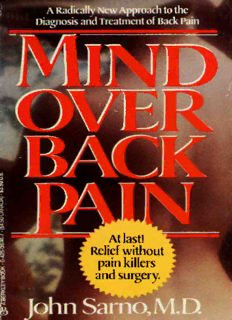
Mind Over Back Pain: A Radically New Approach to the Diagnosis and Treatment of Back Pain PDF
Preview Mind Over Back Pain: A Radically New Approach to the Diagnosis and Treatment of Back Pain
A Radically NewApproach to the Diagnosis and Treatment of Back Pain 1 Digitized by the Internet Arciiive in 2010 http://www.arcliive.org/details/mindoverbackpainOOsarn — Tension Myositis Syndrome Cause and Treatment "Among most victims ofback pain, TENSION leads to a phys- ical process involving the muscles and nerves of the neck, shoulders and back. I call this condition the tension myositis syndrome (TMS). "TMS is characterized by varied patterns of pain in the neck, shoulders, upper or lower back and often in the legs and arms as well. Pain can occur with increasing frequency over many years, and in some people it eventually becomes chronic. It can dominate a person's life. Pain and the fear of pain sharply re- strict physical activity. "I have learned in working with TMS that human beings have great capacities for self-healing; but those powers must be rec- ognized and unleashed. In my view this is the best medicine: releasing the potential within individuals to heal themselves." —John Sarno, M.D. Most Berkley Books are available at special quantity discounts for bulk purchases forsalespromotions, premiums, fund raising, oreducational use. Specialbooksorbookexcerptscanalsobecreatedtofitspecificneeds. For details, write or telephone Special Sales Markets, The Berkley Publishing Group, 200 Madison Avenue, New York, New York I00I6; (212)686-9820. A Radically NewApproach tothe Diagnosis and Treatmentof Back Pain MIND OVER BACK by John Sarno, M.D. S. BERKLEY BOOKS, NEWYORK This Berkley book contains the complete text ofthe original hardcover edition. MIND OVER BACK PAIN A Berkley Book / published by arrangement with William Morrow and Company, Inc. PRINTING HISTORY William Morrow edition published 1984 Berkley edition / April 1986 All rights reserved. © Copyright 1982 by John E. Samo. This book may not be reproduced in whole or in part, by mimeograph or any other means, without permission. For information address: William Morrow and Company. Inc., 105 Madison Avenue, New York. New York 10016. ISBN: 0-425-08741-7 A BERKLEY BOOK ^ TM 757,375 Berkley Books are published by The Berkley Publishing Group, 200 Madison Avenue, New York, New York 10016. The name "BERKLEY" and the stylized "B" with design are trademarks belonging to Berkley Publishing Corporation. PRINTEDINTHEUNITED STATESOFAMERICA Acknowledgments Though the writing of this book was started a number of years ago, the fact that it has become a reality is primarily due to the interest, encouragement and activity of Michael Shimkin. He was the prime mover in setting the publication wheels in motion. He has also been of great help in reading and critiquing the manuscript as it developed. My wife, Martha, as always, has contributed to the project in many ways. From her considerable medical writing experience, she made suggestions ranging from organization to syntax. Her sensitivity to psychological phenomena made her an ideal discussant as I worked to clarify concepts. David Schechter, while still a third-year medical student, col- lected the data that comprise the follow-up study reported in the text. In addition, he made excellent suggestions after multiple readings of the manuscript. Howard A. Rusk has been many things to me over the years. He is the philosophical father of the medical specialty of Rehabilitation Medicine. He introduced me to the field, and was a constant source of support and encouragement during the years that I worked under his departmental chairmanship. Because of his clinical sensitivity and deep understanding of patient needs, he was particularly supportive of my work on back pain. The many workers who have contributed to the field of psycho- somatic medicine are too numerous to list, but one thinks with partic- ular gratitude of a few pioneers such as Franz Alexander, Flanders Dunbar and George Engel. Acknowledgments I would be remiss if I did not acknowledge the contributions of the members of the team at the Institute of Rehabilitation Medicine who worked with me through the years in the treatment of patients. They have been devoted, sensitive and caring. In particular I am grate- ful to Arlene Feinblatt, the chief psychologist of our group, for her contribution to the understanding of the psychological basis for the tension myositis syndrome and to Roberta Weiss, Phyllis Israelton and Nancy Berk for their work in developing appropriate physical thera- peutic techniques. I owe thanks as well to my patients, for they have been the text- books from whom I have learned about this disorder. I am particularly grateful to Cinda Firestone for her gracious and generous support of the back pain program. She also kindly consented to read the manuscript and in the process made many valuable sugges- tions. Elizabeth Frost Knappman made important organizational sugges- tions at a crucial time in the writing of the book, for which I am very grateful. To Mary Bleecker Simmons goes the credit for the title of the book. Finally, my thanks for the loyalty and industriousness of Ana Torres, who typed the seemingly endless pages that led to the final manuscript. Contents Introduction 9 Chapter Structural Abnormalities Rarely Cause 13 1 Back Pain Chapter 2 Conventional Treatment and Medical 33 Mythology Chapter 3 What Causes Back Pain? 50 The Psychophysiology of TMS Chapter 4
Description: